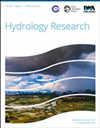基于机器学习的无测站流域丘陵地区山洪暴发峰值预测
IF 2.4
4区 环境科学与生态学
Q2 Environmental Science
引用次数: 0
摘要
洪峰流量是水文预报的基本要素。由于山丘地区山洪暴发迅速且缺乏测量数据,因此快速准确地估算峰值排水量对于山洪灾害管理至关重要。本文应用了三种机器学习算法来估算峰值排水量,并将估算结果与水文-水力模型的结果进行了比较,同时与流域实测数据进行了验证。本文选取了 10 个水文地质参数来预测太乙山北区 103 个流域的洪峰流量。结果表明,粒子群优化反向传播(PSO-BP)神经网络模型的预测性能优于 BP 神经网络和随机森林回归。PSO-BP 的平均绝对误差(2.51%)、均方根误差(3.74%)和平均绝对百分比误差(2.74%)均低于其他模型,表明 PSO-BP 具有较高的预测精度。重要度分析表明,降雨量、早期影响降雨量、流域面积和降雨强度是 PSO-BP 的关键输入参数。研究证实,所提出的方法是一种快速、相对准确的估算无测站流域山洪峰值流量的算法。本文章由计算机程序翻译,如有差异,请以英文原文为准。
Prediction of flash flood peak discharge in hilly areas with ungauged basins based on machine learning
Peak discharge is an essential element of hydrological forecasting. Due to rapid outbreaks of flash floods in hilly areas and the lack of measured data, the fast and accurate estimation of peak discharge is crucial for flash flood hazard management. Three machine learning algorithms were applied to estimate peak discharge; this estimation was compared with the results of hydrological–hydraulic models, and the results were verified with measured watershed data. In this paper, 10 hydrological and geomorphological parameters were selected to predict the flood peak discharge in 103 watersheds in Taiyi Mountain North District. The results show that the particle swarm optimization backpropagation (PSO-BP) neural network model outperforms the BP neural network and random forest regression in prediction performance. PSO-BP has a lower mean absolute error (2.51%), root mean square error (3.74%), and mean absolute percentage error (2.74%) than the other models, which indicates that PSO-BP has high prediction accuracy. Importance analysis revealed that rainfall, early impact rainfall, catchment area, and rain intensity are the key input parameters of PSO-BP. The proposed method was confirmed to be a fast and relatively accurate algorithm for estimating the peak discharge of flash floods in ungauged basins.
求助全文
通过发布文献求助,成功后即可免费获取论文全文。
去求助
来源期刊

Hydrology Research
Environmental Science-Water Science and Technology
CiteScore
5.30
自引率
7.40%
发文量
70
审稿时长
17 weeks
期刊介绍:
Hydrology Research provides international coverage on all aspects of hydrology in its widest sense, and welcomes the submission of papers from across the subject. While emphasis is placed on studies of the hydrological cycle, the Journal also covers the physics and chemistry of water. Hydrology Research is intended to be a link between basic hydrological research and the practical application of scientific results within the broad field of water management.
 求助内容:
求助内容: 应助结果提醒方式:
应助结果提醒方式:


